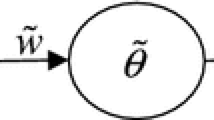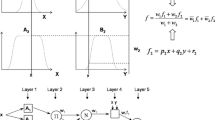Abstract
Most methods for fitting an uncertain yield learning process involve using fuzzy logic and solving mathematical programming (MP) problems, and thus have several drawbacks. The present study proposed a novel fuzzy and artificial neural network (ANN) approach for overcoming these drawbacks. In the proposed methodology, an ANN is used instead of an MP model to facilitate generating feasible solutions. A two-stage procedure is established to train the ANN. The proposed methodology and several existing methods were applied to a real case in a semiconductor manufacturing factory, and the experimental results showed that the methodology outperformed the existing methods in the overall forecasting performance.











Similar content being viewed by others
References
Babikir A, Mwambi H (2017) Factor augmented artificial neural network model. Neural Process Lett 45(2):507–521
Bitran GR, Dasu S (1992) Ordering policies in an environment of stochastic yields and substitutable demands. Oper Res 40(5):999–1017
Chen T (2009) Estimating and incorporating the effects of a future QE project into the semiconductor yield learning model with a fuzzy set approach. Eur J Ind Eng 3(2):207–226
Chen T, Lin YC (2008) A fuzzy-neural system incorporating unequally important expert opinions for semiconductor yield forecasting. Int J Uncertain Fuzziness Knowl Based Syst 16(1):35–58
Chen FL, Liu SF (2000) A neural-network approach to recognize defect spatial pattern in semiconductor fabrication. IEEE Trans Semicond Manuf 13(3):366–373
Chen T, Tsai HR (2017) Ubiquitous manufacturing: Current practices, challenges, and opportunities. Robot Comput Integr Manuf 45:126–132
Chen T, Wang MJJ (1999) A fuzzy set approach for yield learning modeling in wafer manufacturing. IEEE Trans Semicond Manuf 12(2):252–258
Chen T, Wang YC (2013) Semiconductor yield forecasting using quadratic-programming based fuzzy collaborative intelligence approach. Math Prob Eng 2013:672404
Chen T, Wang YC (2014) An agent-based fuzzy collaborative intelligence approach for precise and accurate semiconductor yield forecasting. IEEE Trans Fuzzy Syst 22(1):201–211
Donoso S, Marin N, Vila MA (2006) Quadratic programming models for fuzzy regression. In: Proceedings of international conference on mathematical and statistical modeling in Honor of Enrique Castillo
Gaeta M, Loia V, Tomasiello S (2013) A generalized functional network for a classifier-quantifiers scheme in a gas-sensing system. Int J Intell Syst 28(10):988–1009
Gruber H (1994) Learning and strategic product innovation: theory and evidence for the semiconductor industry. Elsevier, The Netherlands
Helmy T, Al-Nazer A (2015) Semantic manipulation of user’s queries and modeling the health and nutrition preferences. J Ambient Intell Human Comput 6(4):391–405
Kosmides P, Demestichas K, Adamopoulou E, Remoundou C, Loumiotis I, Theologou M, Anagnostou M (2016) Providing recommendations on location-based social networks. J Ambient Intell Human Comput 7(4):567–578
Kumar N, Kennedy K, Gildersleeve K, Abelson R, Mastrangelo CM, Montgomery DC (2006) A review of yield modelling techniques for semiconductor manufacturing. Int J Prod Res 44(23):5019–5036
Li DC, Yeh CW, Chen CC, Shih HT (2016) Using a diffusion wavelet neural network for short-term time series learning in the wafer level chip scale package process. J Intell Manuf 27(6):1261–1272
Mazzola JB, McCardle KF (1997) The stochastic learning curve: optimal production in the presence of learning-curve uncertainty. Oper Res 45(3):440–450
Peters G (1994) Fuzzy linear regression with fuzzy intervals. Fuzzy Sets Syst 63:45–55
Scarselli F, Tsoi AC (1998) Universal approximation using feedforward neural networks: a survey of some existing methods, and some new results. Neural Netw 11(1):15–37
Stefanini L, Sorini L, Guerra ML (2008) Fuzzy numbers and fuzzy arithmetic. Handbook of granular computing, pp 249–283
Tanaka H, Watada J (1988) Possibilistic linear systems and their application to the linear regression model. Fuzzy Sets Syst 272:275–289
Tomasiello S (2011) A functional network to predict fresh and hardened properties of self-compacting concretes. Int J Numer Methods Biomed Eng 27(6):840–847
Watada J, Tanaka H, Shimomura T (1986) Identification of learning curve based on possibilistic concepts. Applications of fuzzy set theory in human factors. Elsevier, Amsterdam, pp 191–208
Wu HC, Chen T (2015) CART–BPN approach for estimating cycle time in wafer fabrication. J Ambient Intell Human Comput 6:57–67
Wu CW, Pearn WL, Kotz S (2009) An overview of theory and practice on process capability indices for quality assurance. Int J Prod Econ 117(2):338–359
Xue S, Xiong L, Yang S, Zhao L (2016) A self-adaptive multi-view framework for multi-source information service in cloud ITS. J Ambient Intell Human Comput 7(2):205–220
Yang S, Yang J, Abdel-Malek L (2007) Sourcing with random yields and stochastic demand: a newsvendor approach. Comput Oper Res 34(12):3682–3690
Zhang T, Fu W, Ye J, Fischer M (2017) Learning movement patterns of the occupant in smart home environments: an unsupervised learning approach. J Ambient Intell Human Comput 8:133–146
Acknowledgements
This study was sponsored by the Ministry of Science and Technology, Taiwan.
Author information
Authors and Affiliations
Corresponding author
Rights and permissions
About this article
Cite this article
Chen, T. An innovative fuzzy and artificial neural network approach for forecasting yield under an uncertain learning environment. J Ambient Intell Human Comput 9, 1013–1025 (2018). https://doi.org/10.1007/s12652-017-0504-6
Received:
Accepted:
Published:
Issue Date:
DOI: https://doi.org/10.1007/s12652-017-0504-6




